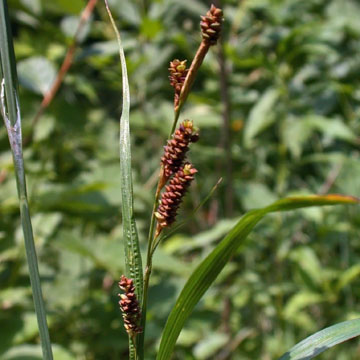

Carex shortiana - (image 1 of 4)
Taxonomy
Family: Cyperaceae
Section Shortianae
Habitat
Moist woods and meadows, bottomlands, often in calcareous soil.
Associates
Distribution
PA and southwest Ontario to IN, IA, MO, KS, and TN.
Morphology
Plants cespitose; stems stout, 40-80 cm; main leaves 4-8 mm wide; spikes 4-6, cylindric, erect, the terminal gynaecandrous, the lateral pistillate, the lowest on long slender peduncles, the others on progressively shorter peduncles or subsessile; bracts leaf-like, sheathless or nearly so; pistillate scales ovate, about as long as the perigynia, reddish-brown, acute or rounded and mucronate at the apex; perigynia spreading, flattened-trigonous, broadly obovate, 1.8-2.6 mm long and nearly as wide, cuneate to the base, 2-ribbed at the lateral angles, otherwise nerveless, minutely apiculate; achene concavely trigonous.
Notes
Fruiting late May to mid-July
Wetland indicator: FACW
Listed as endangered in NY but of the three extant populations in the state two were first identified in the mid-1990's and one in 2008, so it is thought that it may have been introduced (there is one collection from Long Island from 1904). Most common west of the Allegheny Mountains. The only species in section Shortianae though known to produce sterile hybrids with C. typhina and C. squarrosa of section Squarrosae.
References
Ball, P.W. and A.A. Reznicek. 2002. Carex, In: Flora of North America Editorial Committee, Eds. Flora of North America North of Mexico. Volume 23. Oxford University Press, New York.
Gleason, Henry A. and A. Cronquist. 1991. Manual of Vascular Plants of
Northeastern United States and Adjacent Canada. Second Ed.
The New York Botanical Garden. Bronx, NY
|
© Michael Hough 2018 |